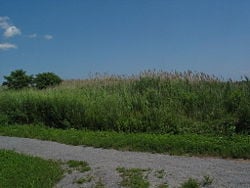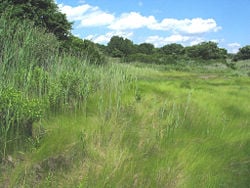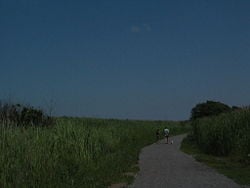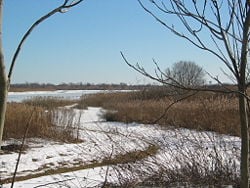Difference between revisions of "Salt marsh" - New World Encyclopedia
Katya Swarts (talk | contribs) (added article and credit tags) |
Rick Swarts (talk | contribs) |
||
| Line 1: | Line 1: | ||
| + | {{Claimed}} | ||
[[Image:Bride-Brook-Salt-Marsh-s.jpg|thumb|250px|right|An [[Atlantic Ocean|Atlantic]] coastal salt marsh in [[Connecticut]].]] | [[Image:Bride-Brook-Salt-Marsh-s.jpg|thumb|250px|right|An [[Atlantic Ocean|Atlantic]] coastal salt marsh in [[Connecticut]].]] | ||
[[Image:SaltMarsh-Weed.JPG|thumb|250px|A weed salt marsh in the [[Marine Park Nature]] Center in [[Brooklyn]], [[New York]].]] | [[Image:SaltMarsh-Weed.JPG|thumb|250px|A weed salt marsh in the [[Marine Park Nature]] Center in [[Brooklyn]], [[New York]].]] | ||
Revision as of 01:10, 29 May 2007
A salt marsh is a type of marsh that is a transitional zone between land and salty or brackish water (e.g., sloughs, bays, estuaries). It is dominated by halophytic (salt tolerant) herbaceous plants. Historically, salt marshes have sometimes been treated as "wastelands", along with other wetlands. We now know that salt marshes are one of the most biologically productive habitats on the planet, rivaling tropical rainforests. This is partly due to the daily tidal surges that bring in nutrients, the natural chemical activity of salty (or brackish) water, the tendency of nutrients to settle in roots of the plants there, and the tendency of algae to bloom in the shallow unshaded water. Salt marshes also provide a benefit by protecting against severe weather, such as in the North American Gulf Coast. In the past, substantial areas of saltmarsh have been reclaimed as agricultural land and for urban development, but in the US and Europe they are now accorded a high level of protection by the Clean Water Act and the Habitats Directive respectively. There is growing interest in restoring salt marshes, through a process of managed retreat.
Conditions required
Salt marshes develop on depositional coasts, bays, and estuaries where tidal action is relatively gentle and erosion no more than intermittent and light enough to allow vegetation to take hold. They are common on low-energy coasts such as estuaries, enclosed bays, and the land sides of barrier islands and strips.
Vegetation
Plant species diversity is relatively low, since the flora must be tolerant of salt, complete or partial submersion, and anoxic mud substrate. The most common salt marsh plants are glassworts (Salicornia spp.) and the cord grasses (Spartina spp.), which have worldwide distribution. They are often the first plants to take hold in a mudflat and begin its ecological succession into a salt marsh. Their shoots lift the main flow of the tide above the mud surface while their roots spread into the substrate and stabilize the sticky mud and carry oxygen into it so that other plants can establish themselves as well. Plants such as sea lavenders (Limonium spp.), plantains (Plantago spp.), and varied sedges and rushes grow once the mud has been vegetated by the pioneer species.
The flora of a salt marsh is differentiated into levels according to the plants' individual tolerance of salinity and water table levels. Vegetation found at the water must be able to survive high salt concentrations, periodical submersion, and a certain amount of water movement, while plants further inland in the marsh can sometimes experience dry, low-nutrient conditions.
Salt marshes are quite photosynthetically active and are extremely productive habitats. They serve as depositories for a large amount of organic matter, and are full of decomposition, which feeds a broad food chain of organisms from bacteria to mammals. Interestingly (in such a biologically productive biome), many of the halophytic plants such as cordgrass are not grazed at all by higher animals, but die off and decompose, to become food for micro-organisms, which in turn become food for fish and in turn birds.
In wintertime the saltmarsh looks more open than in summer. More space is seen between reeds as snow falls between them. The water partly freezes, which makes it look rather spectacular.
Marais salants
In warmer climates, salt can be produced by solar energy so that the French equivalent of the salt marsh, the marais salant has come to be envisaged primarily as an industrial plant, though classified as a form of agriculture, known in French as saliculture. For this aspect of the salt marsh, see Salt evaporation pond.
Wetland dieback
In the summer and fall of 2002, Dr. Scott Warren at Connecticut College and Ron Rozsa of the Connecticut Department of Environmental Protection, noticed the sudden (within one year) disappearance of emergent vegetation at several south shore Cape Cod wetlands connected to Nantucket Sound. The vegetation loss could not be explained by any typical New England causes of vegetation loss such as ice, wrack or herbivory (e.g., geese or muskrat).[1]
Four years later, the cause is still unknown, but there are 17 suspected dieback marshes on Cape Cod, and a few other possible sites are on the North and South Shore, according to the Wetland Restoration Program of the Massachusetts Office of Coastal Zone Management.
In Louisiana, 300,000 acres (1200 km²) turned brown around the year 2000. In 2002, researchers noticed that about 2,000 acres (8 km²) of salt marsh in Georgia turned to mud, similar to what is happening in New England. But as of mid-2006, the Louisiana and Georgia marshes are growing back — or at least not getting worse — while marshes on the Cape do not seem to be recovering naturally. [2]
External links
- Geography resource for schools
- Salt Marsh Nature Center located in the Marine Park section of Brooklyn, New York, USA
Credits
New World Encyclopedia writers and editors rewrote and completed the Wikipedia article in accordance with New World Encyclopedia standards. This article abides by terms of the Creative Commons CC-by-sa 3.0 License (CC-by-sa), which may be used and disseminated with proper attribution. Credit is due under the terms of this license that can reference both the New World Encyclopedia contributors and the selfless volunteer contributors of the Wikimedia Foundation. To cite this article click here for a list of acceptable citing formats.The history of earlier contributions by wikipedians is accessible to researchers here:
The history of this article since it was imported to New World Encyclopedia:
Note: Some restrictions may apply to use of individual images which are separately licensed.




